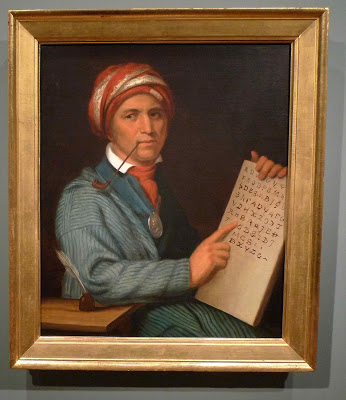
The Cherokees settled in the American Southeast portion of the country. The tribe was of Iroquoian descent. They had originally been from the Great Lakes region of the country, but eventually settled closer to the east coast. They were a strong tribe with several smaller sections, all lead by chiefs. The tribe was highly religious and spiritual. When the American Revolution took place, the Cherokee Indians supported the British soldiers, and even assisted them in battle by taking part in several attacks. The Creek and Choctaw tribes also assisted in the battles on the British side.
Eventually around the 1800s, the Cherokee Indians began to adopt the culture that the white man brought to them. They began to dress more European, and even adopted many of their farming and building methods. In 1828, gold was discovered on the Cherokee’s land. This prompted the overtaking of their homes, and they were forced out. They had been settled in Georgia for many years, but were now being made to leave and find a new place to settle. This is the origin for the historically popular Trail of Tears, where men, women, and children had to pack up their belongings and find new homes, marching a span of thousands of miles. When all was said and done, about 4,000 Cherokee lost their lives on the journey.
Sequoyah also called George Gist was born about 1775 in Taskigi, North Carolina and died in August 1843 near San Fernando, Mexico. He was the creator of the Cherokee writing system (see Cherokee language). Sequoyah was Cherokee on his mother’s side. He was an accomplished silversmith, painter, and warrior and served with the U.S. Army in the Creek War in 1813–14.
Sequoyah became convinced that the secret of what he considered the white people’s superior power was the written language, which enabled them to accumulate and transmit more knowledge than was possible for a people dependent on memory and word of mouth.
Accordingly, about 1809 he began working to develop a system of writing for the Cherokees, believing that increased knowledge would help them maintain their independence. He experimented first with pictographs and then with symbols representing the syllables of the spoken Cherokee language, adapting letters from English, Greek, and Hebrew. His daughter helped him to identify the Cherokee syllables. By 1821 he had created a system of 86 symbols, representing all the syllables of the Cherokee language.
Sequoyah convinced his people of the utility of his syllabary by transmitting messages between the Cherokees of Arkansas (with whom he went to live) and those of the east and by teaching his daughter and other young people of the tribe to write. The simplicity of his system enabled pupils to learn it rapidly, and soon Cherokees throughout the nation were teaching it in their schools and publishing books and newspapers in their own Cherokee language.
Sequoyah’s name (spelled Sequoia) was given to the giant redwoods (Sequoia sempervirens) of the Pacific Coast and the big trees (Sequoiadendron giganteum) of the Sierra Nevada range. The Cherokee rose is now the state flower of Georgia. Today, the largest population of Cherokee Indians live in the state of Oklahoma, where there are three federally recognized Cherokee communities with thousands of residents.
Adapted from http://www.indians.org/articles/cherokee-indians.html and http://www.britannica.com/biography/Sequoyah

